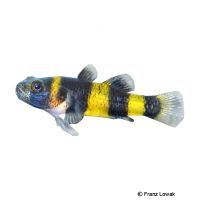Schooling Bumblebee Goby (Brachygobius aggregatus)
| Schooling Bumblebee Goby Brachygobius aggregatus | |
|---|---|
| Name | Schooling Bumblebee Goby |
| Name Lat. | Brachygobius aggregatus |
| Family | Gobies |
| Family lat. | Gobiidae |
| Order | Gobies |
| Order lat. | Gobiiformes |
| Origin | Southeast Asia |
| Habitat | Streams, rivers |
| Diet | Carnivore |
| pH | 6.5-7.5 |
| Behavior | Peaceful |
| Keeping | Pair, group |
| Care Level | Moderate |
| Reproduction | Cave spawner |
| Breeding | Difficult |
| Life Span | 3-4 years |
| Protection | No |
| Metric Units | |
| Size | 1-2 cm |
| Temperature | 18-28 °C |
| Hardness | 10-20 °dH |
| Aquarium | 60 cm / 54 l |
| US Units | |
| Size | 0.4"-0.8" |
| Temperature | 64-82 °F |
| Hardness | 178-356 ppm |
| Aquarium | 15 gal |
Distribution and habitat
The distribution area of the Mekong dwarf golden goby is in Vietnam, where they are mainly found in the
shallow waters of the lower Mekong River to its mouth, but also in marshes and channels with muddy sandy bottoms, dense underwater vegetation, fallen leaves and roots.
Maintenance
The aquarium should have dense planting, with numerous hiding places (caves, crevices, shelters) of stones and roots, as well as some free sand areas. A dark, soft substrate covered with some foliage (e.g. sea almond leaves) and slightly shaded light (floating plants) is ideal
No ammonia, ammonium and nitrite should be detectable, the nitrate value should not exceed 100 mg/l. To ensure the water quality and oxygen content, a filter and heater adapted to the aquarium size is required, as well as lighting for the species-appropriate day-night rhythm of the animals.
Diet
In nature they feed on insects, small crustaceans and plankton. The diet consists of small live foods, such as cyclops, daphnia, bosmids and artemia, which are also well accepted in frozen form, supplemented with a commercially available frozen special food mix. Dry food is rarely accepted
Only as much should be fed as is eaten within a few minutes. It is recommended to feed small portions several times a day. A regular and varied diet promotes health and increases resistance
Behaviour and compatibility
It is recommended to keep them in pairs or better in a group of 6 or more animals in a species tank. They occupy small territories around their living and breeding caves, which they defend against conspecifics. Group keeping is only recommended in a larger and richly structured aquarium. Towards other fish they behave completely peacefully
Basically, only compatible fish species with similar demands on water quality and water temperature may be socialized.
Sex dimorphism
The sexes are difficult to distinguish. The males are slimmer and more intensely colored at spawning time than the somewhat larger and plumper females.
Reproduction and breeding
They are cave breeders. After a harmonizing pair is found, the female spawns the eggs in a cave (clay tube, small flowerpot, etc.) or under a rock or root. The brood is intensively guarded by the male. After 5-6 days the larvae hatch, after another 2 days they swim free and the brood care ends
Fry must be fed several times a day with special rearing food, such as slipper lizards and later with Artemia nauplii. In community tanks breeding is hardly possible, because the fry are easy prey here.
Important
The foliage (e.g., sea almond tree or oak) not only provides cover, but as it rots it promotes the development of microorganisms that provide a valuable secondary food source.
The well-being of the fish should be monitored regularly. Temperature should be checked daily, pH, hardness and nitrate levels at least every 14 days. Regular partial water changes are recommended, even when contaminant levels have not yet reached the upper limit. Sudden changes in water quality should be avoided. Newly introduced fish must be accustomed slowly to the water in the aquarium.
Further literature can be found in your pet store.
References
Text: petdata; Image: Franz Lowak
Source: BMELV (1998): Tierschutzgutachten - Haltung von Zierfischen (Süßwasser); ENGELMANN (2005): Zootierhaltung - Tiere in menschlicher Obhut: Fische, Verlag Harri Deutsch
- Gemäß § 21 Abs. 5 Tierschutzgesetz idgF
